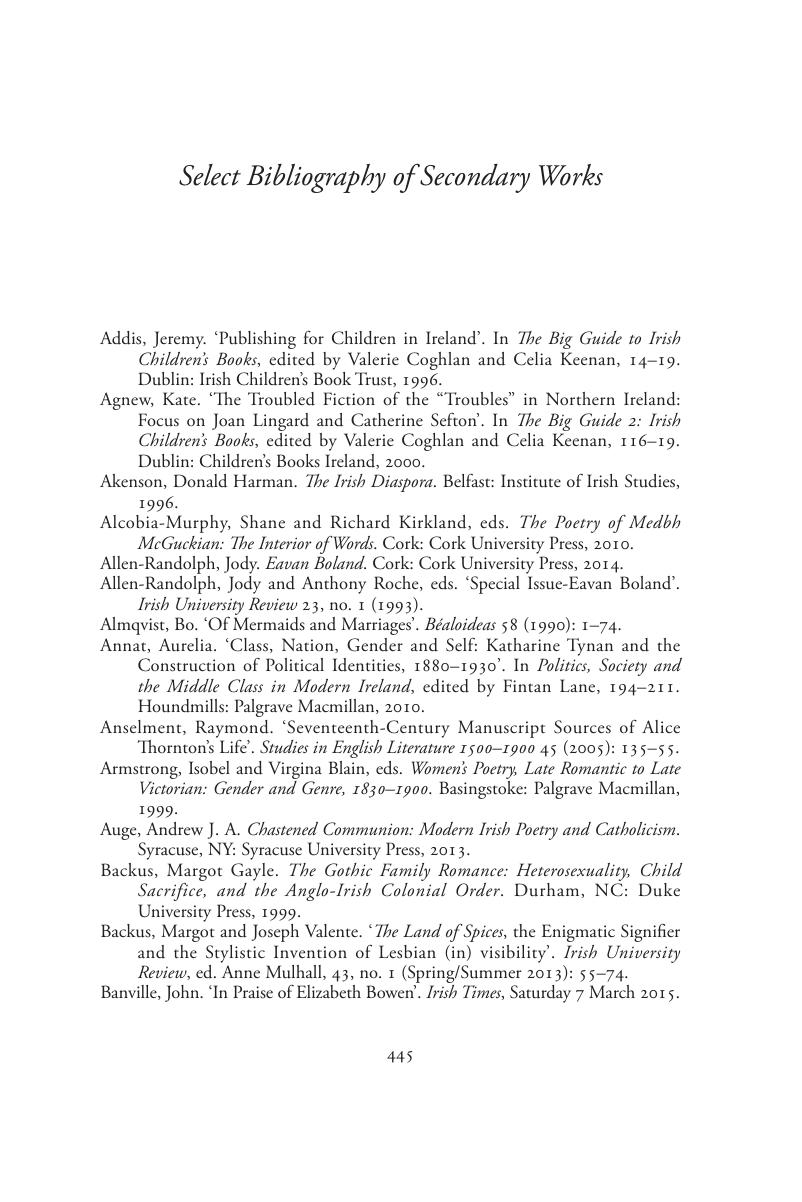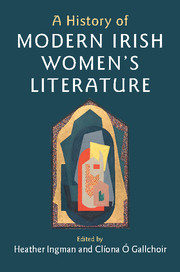Book contents
- A History of Modern Irish Women's Literature
- A History of Modern Irish Women's Literature
- Copyright page
- Contents
- Notes on Contributors
- Introduction
- Chapter 1 Writing before 1700
- Chapter 2 Eighteenth-Century Writing
- Chapter 3 Writing under the Union, 1800–1845
- Chapter 4 Poetry, 1845–1891
- Chapter 5 Fiction, 1845–1900
- Chapter 6 New Woman Writers
- Chapter 7 Poetry, Drama and Prose, 1891–1920
- Chapter 8 Writing for Children
- Chapter 9 Poetry, 1920–1970
- Chapter 10 Fiction, 1922–1960
- Chapter 11 Elizabeth Bowen
- Chapter 12 Kate O'Brien
- Chapter 13 Edna O'Brien
- Chapter 14 Fiction 1960–1995
- Chapter 15 The Short Story
- Chapter 16 Poetry, 1970–Present
- Chapter 17 Women's Traditions in Theatre, 1920–2015
- Chapter 18 Writing in Irish, 1900–2013
- Chapter 19 Fiction from Northern Ireland, 1921–2015
- Chapter 20 Life Writing and Personal Testimony, 1970–Present
- Chapter 21 Diasporic and Transnational Writing, 1950–Present
- Chapter 22 Celtic Tiger Fiction
- Select Bibliography of Secondary Works
- Index
- References
Select Bibliography of Secondary Works
Published online by Cambridge University Press: 30 August 2018
- A History of Modern Irish Women's Literature
- A History of Modern Irish Women's Literature
- Copyright page
- Contents
- Notes on Contributors
- Introduction
- Chapter 1 Writing before 1700
- Chapter 2 Eighteenth-Century Writing
- Chapter 3 Writing under the Union, 1800–1845
- Chapter 4 Poetry, 1845–1891
- Chapter 5 Fiction, 1845–1900
- Chapter 6 New Woman Writers
- Chapter 7 Poetry, Drama and Prose, 1891–1920
- Chapter 8 Writing for Children
- Chapter 9 Poetry, 1920–1970
- Chapter 10 Fiction, 1922–1960
- Chapter 11 Elizabeth Bowen
- Chapter 12 Kate O'Brien
- Chapter 13 Edna O'Brien
- Chapter 14 Fiction 1960–1995
- Chapter 15 The Short Story
- Chapter 16 Poetry, 1970–Present
- Chapter 17 Women's Traditions in Theatre, 1920–2015
- Chapter 18 Writing in Irish, 1900–2013
- Chapter 19 Fiction from Northern Ireland, 1921–2015
- Chapter 20 Life Writing and Personal Testimony, 1970–Present
- Chapter 21 Diasporic and Transnational Writing, 1950–Present
- Chapter 22 Celtic Tiger Fiction
- Select Bibliography of Secondary Works
- Index
- References
Summary

- Type
- Chapter
- Information
- A History of Modern Irish Women's Literature , pp. 445 - 472Publisher: Cambridge University PressPrint publication year: 2018

